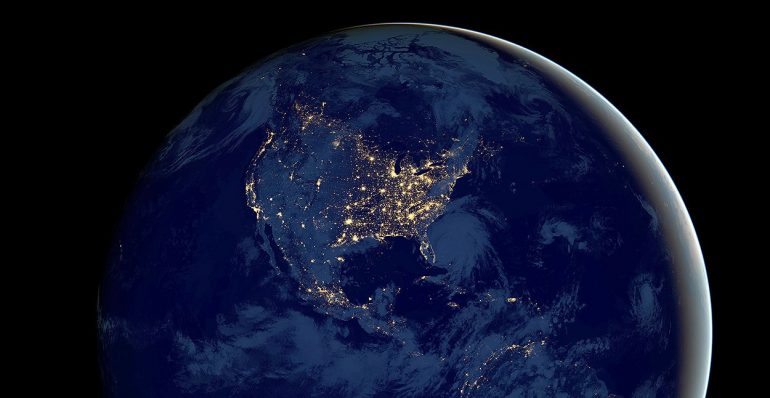Renewable energy is considered a natural and environmentally friendly alternative to fossil fuels. But with the use of wind, sun and the like, we also interfere with the natural energy flow of the earth. Researchers have now calculated how much energy we can “tap” from the Earth system before the planetary load limit is exceeded. They also determined which form of renewable energy is most effective in this regard.
Humanity consumes more resources than the Earth can sustainably supply. In addition, humans produce millions of tons of plastic every year that end up as waste in the environment. As a result, we are already endangering a large part of the ecosystem, climate and biodiversity. To give relief to the Earth, more and more researchers are invoking the concept of sustainable recycling management. The material should be used, processed and reused for as long as possible so as not to be destroyed as waste. In a truly sustainable society, however, not only the physical flow but also the energy flow has to remain within the limits set by our home planet.
How much energy can humanity “tap”?
Hence a central question is: Is there enough renewable energy available globally for our sustainable economy without crossing planetary boundaries? It has been investigated by scientists working with Herald Dessing of the Federal Materials Testing and Research Institute, Empa. To do this, he first considered how large a portion of renewable energy can be that people get distracted by the natural energy flow of the Earth. Because the Earth itself uses solar energy, for example, to “keep the oceans, the atmosphere and the forests in operation”, but also to reflect the ice surfaces. Most of these subsystems convert energy, largely supplied by solar radiation, to other forms of energy, for example in wind and water streams or biomass production. Regardless of use, whether in the natural earth system or in the man-made technological field, all the energy is eventually radiated back into space.
If people now use the natural energy flow of the Earth, then the ratio available to the Earth system decreases. Earth systems can only compensate for such disturbances to a certain extent. If they are too large, the so-called tipping points can be crossed. This leads to rapid and irreversible changes in the Earth system, for example melting polar ice caps, which in turn intensify climate change. To prevent this, the size of the land used for energy production should not exceed the load limit of the earth. Furthermore, the way the field is used is decisive: for example, the construction of solar systems in former forest areas disrupts biodiversity, evaporation of water and reflection of heat in space. The same upper limits for solar use also apply to the use of chemical energy, for example from biomass.
To be able to investigate these aspects and influence factors, the research team converted the various possibilities of renewable energy into electrical energy equivalents. In doing so, he based these calculations on the potential of power plant technology available today. In this way, they were able to determine how much energy mankind is allowed to withdraw from the Earth system and use for themselves and which renewable energy is the most “economical”.
We should use 0.04 percent
Result: The Earth system itself requires a large portion of the available energy. Therefore 99.96 percent of the energy that reaches Earth from space is required to run the Earth system and produce food. If a planet is not to cross its boundaries, mankind can technically use only 0.04 percent of the total energy – that is, power generation, heat production and the like, as Dessing and his team have determined. However, this capacity is still nearly ten times greater than today’s global energy demand.
The calculation also showed: The most efficient way to generate energy would be to use solar energy, as it leads to the lowest conversion loss. Because almost all renewable energy resources – including wind and water power as well as biomass production – are ultimately powered by the sun. If you use solar energy directly, less energy is lost. All other energy efficiencies, for example from wind or biomass, are orders of magnitude smaller than the direct use of solar energy – and some of them are already heavily exploited, as the research team points out. Nevertheless, they can play an important role locally, especially because they can reduce the need for storage capacity.
Solar Power: The Problem Is In Implementation
According to the team, it would be the cheapest and gentle if all surfaces are already sealed, such as the roof and façade, but roads, rails and parking lots are used for solar power. According to the researchers, these regions alone would be sufficient to supply a global society with moderate to low power consumption. If there is more demand, desert areas will also have to be used. However, it is technically and logically complex and therefore only makes sense when all other options are actually exhausted.
However, the use of solar energy also has its limitations, as Desing and his colleagues point out. In theory, this offers great potential for generating energy in a sustainable circular economy. However, the amount of energy actually available will be less. Because there are many factors that limit the practical use of such systems. This includes the availability of raw materials, but also financial capital and manpower to build solar systems. In addition, the extraction and production of raw materials, as well as the operation and disposal of systems, sometimes have significant environmental impacts. Additionally there are costs, efforts, and environmental interventions for infrastructure, for example for energy distribution and storage.
Source: empa, expert article: energy, Doi: 10.3390 / en12243

Web guru. Amateur thinker. Unapologetic problem solver. Zombie expert. Hipster-friendly travel geek. Social mediaholic.





